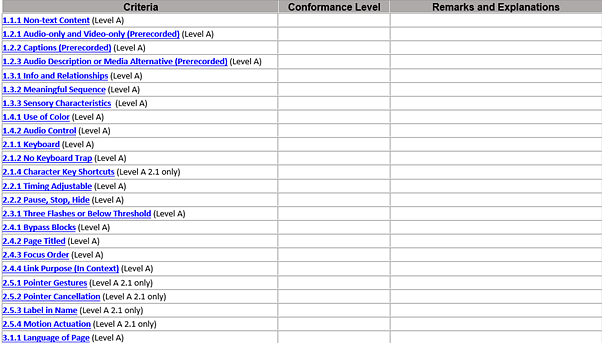The Crucial Role of VPATs and ACRs in Ensuring Inclusive Digital Procurement
18 July 2024 - Kieran Rooney & Snigdha Ramkumar

In our increasingly interconnected digital world, accessibility has evolved from a desirable feature to a fundamental necessity, ensuring an inclusive experience for all users. The Voluntary Product Accessibility Template (VPAT) and Accessibility Conformance Report (ACR) are key tools for assessing the accessibility of digital products and services. This article delves into the essence of VPATs and ACRs, highlighting their vital roles in the procurement process and offering guidance for both procurement teams and vendors.
The VPAT is a structured document that outlines the accessibility features and compliance of a specific digital product or service. It serves as a comprehensive checklist, enabling a systematic evaluation of a product against specific accessibility criteria.
- Procurement professionals use VPATs to determine how well a product aligns with established accessibility standards and guidelines.
- VPATs allow vendors to transparently disclose the accessibility features and limitations of their products, placing the onus on them to provide thorough information about their product's accessibility.
This enables organisations, including public entities, to make informed procurement decisions by understanding the accessibility level of a product upfront.

VPATs are available in various editions, each tailored to specific accessibility standards and regional requirements. While primarily vital in public sector procurement for compliance with laws such as Section 508 in the U.S., VPATs are also increasingly important in the private sector under regulations like the UK's Equality Act 2010 and the Americans with Disabilities Act (ADA), as well as sector-specific regulations like the Financial Conduct Authority's Consumer Duty in the UK. Therefore, it's vital for vendors to invest in the creation of accurate and detailed VPATs to maintain competitiveness and compliance across all sectors.
The Accessibility Conformance Report (ACR), typically presented as a completed VPAT, succinctly summarises a product's accessibility level. While a VPAT is not strictly necessary to produce an ACR, using the VPAT format has become a standard practice in the industry. The ACR offers a detailed view of a product's adherence to specific accessibility standards, enhancing the assessment process. ACRs with identified deficiencies do not automatically disqualify a product; instead, they provide critical information for making informed decisions, recognizing the ongoing development of digital products and the potential for continual accessibility improvements.
For procurement teams, especially in public sector organisations, it's essential to have a clear understanding of the required accessibility standards like Section 508 or WCAG (Web Content Accessibility Guidelines) to adhere to international legislation. Teams should be equipped with the knowledge to assess whether a vendor's product meets these standards, scrutinising the VPATs and ACRs for accuracy and thoroughness. Procurement professionals should seek clarification or additional information from vendors if the provided documentation is inadequate or unclear. Key questions procurement teams should ask include:
- When was the last ACR published?
- Have any new features been added since the last report?
- Have these new features been independently tested for compliance?
- To what level has the product been tested?
- What level of compliance does the product meet?
This vigilance ensures that the products procured not only comply with legal standards but also meet the inclusive needs of all users.
In the fast-paced digital world, the importance of regularly updated ACRs becomes increasingly clear. It is recommended to update the ACR every 12 to 18 months, following significant feature releases or major user interface changes. This practice ensures that the ACR accurately reflects the current accessibility status of the product and provides stakeholders with reliable information. Regular updates help prevent potential contractual issues, fostering compliance with accessibility requirements and enabling informed procurement decisions that reflect a commitment to inclusivity.
Utilising the expertise of third-party accessibility consultants for the development and review of VPATs and ACRs is a key strategy. Their expertise helps avoid potential biases inherent in internal management and ensures that the documentation accurately represents the product's accessibility status. An inaccurate or misleading ACR poses significant contractual risks, as organisations are increasingly holding vendors accountable for the accessibility claims made in their ACRs.
VPATs and ACRs also play a broader role beyond procurement. They help embed accessibility into the product development lifecycle and cultivate a culture of inclusivity within an organisation. These documents serve as educational tools for stakeholders, increasing awareness of the importance of accessibility.
Effective collaboration between vendors and procurement teams is vital. It's crucial for procurement professionals to communicate their specific accessibility requirements clearly and for vendors to respond with detailed and transparent VPATs and ACRs. This exchange ensures that procurement teams have all the necessary information to assess a product's compliance thoroughly. Such collaboration fosters a culture of transparency and trust, ultimately reinforcing a commitment to accessibility throughout the procurement process.
In conclusion, VPATs and ACRs are invaluable in procurement, enabling organisations to make educated decisions about the accessibility of digital products and services. By adapting to various accessibility standards and regularly updating these documents with expert insights, they encapsulate precision and efficacy. This commitment to accessibility paves the way for comprehensive inclusivity and equitable access for everyone .
Ready to enhance your digital procurement process? Contact User Vision today for expert guidance on leveraging VPATs and ACRs effectively.
You might also be interested in...
When Did You Last Update Your Accessibility Statement?
11 December 2025Your accessibility statement says more about your organisation than you think. Learn why keeping it current matters for trust, compliance, and user experience—and what UK, EU, and US regulations expect.
Read the article: When Did You Last Update Your Accessibility Statement?Making Hospitality Welcoming for All: A Digital Accessibility Guide for Hotels
21 November 2025Hotels have long focused on physical accessibility, but true inclusion extends online. This practical guide explains how to make your hotel website accessible for all guests—meeting global WCAG and EAA standards, expanding your reach, and creating a seamless booking experience for every visitor.
Read the article: Making Hospitality Welcoming for All: A Digital Accessibility Guide for Hotels3 perspectives on how AI is shaping inclusive digital experiences
10 November 2025AI is transforming digital accessibility — empowering disabled users, enhancing how we evaluate digital experiences, and reshaping how inclusive products are designed. This article explores three key perspectives and highlights how AI can support more equitable, human-centred digital experiences when used thoughtfully and collaboratively.
Read the article: 3 perspectives on how AI is shaping inclusive digital experiences